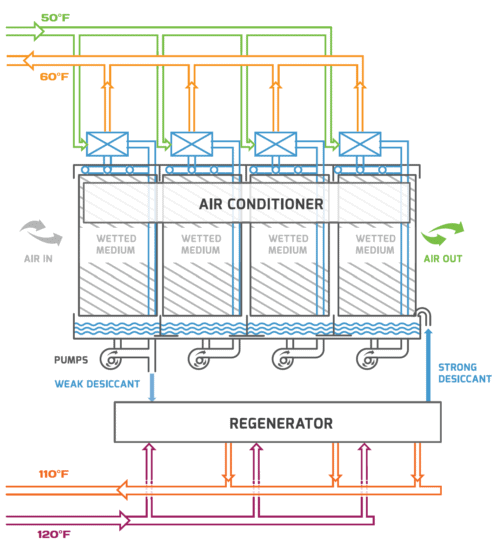Unlike traditional mechanical cooling systems, the AirGreen technology is designed to provide both air conditioning (i.e. – sensible cooling) and dehumidification (latent cooling). It is this combination that allows our system to produce cool and dry conditioned air in a way that maximizes indoor air quality (IAQ), which is becoming more of an importance in light of increasing customer awareness of this issue. Furthermore, this system also kills various airborne pathogens such as molds, bacteria, viruses, and specifically the COVID-19 virus. ASHRAE’s stated position on IAQ is as follows:
“IAQ impacts people’s health, comfort, well-being, learning outcomes, and work performance. Improved IAQ brings substantial health and economic benefits from a broad public health perspective, as well as to individual building owners and occupants.”

Air Conditioning : AirGreen’s technology is comprised of both a multi-stage air conditioning module that cools and dehumidifies, and a regeneration module that is designed to re-concentrate AirGreen’s proprietary desiccant solution. In the air conditioning module, the strong liquid desiccant solution is first cooled via indirect contact with a chilled water source and circulated on a closed-loop basis throughout AirGreen’s proprietary media cassettes. This media presents a cooling surface for the incoming air stream while also stripping the airstream of moisture (humidity). The chilled water source comes most commonly from a water-source heat pump or cogeneration equipment designed for such use.
Each independent stage can be modulated to provide the target conditioned air quality, and chilled water temperatures can either be adjusted or flows can also be modulated to achieve the target results. Depending upon the application, the AirGreen air conditioning module can produce as low as 52oF conditioned air and has demonstrated dehumidification rates up to 93 lbs per hour of moisture removal in just a small 2000 CFM unit. By comparison, the most common large stand-alone modular dehumidifier only removes up to 225 pints of water per day, which converts to 9.7 lbs per hour, approximately 10 times less.
Based on the incoming air conditions AirGreen can cool air to 52-65 oF and the space humidity is maintained air at 40% relative humidity. Custom units that include additional stages can produce even drier air if the application requires it. This novel modular design allows for optimization to meet customer requirements.
Regeneration : The slightly more dilute liquid desiccant is collected and transferred to the AirGreen multi-stage regeneration module for reconcentration. The regeneration module is essentially identical to the air conditioning module, except that it utilizes a hot water energy source to allow for desiccant solution re-concentration. This can be accomplished with moderate temperatures, unlike other desiccant systems. The AirGreen system does not require energy-consuming hot gas regeneration, as dry desiccant wheel systems do, and as such offers significant reductions in energy costs.
The AirGreen system can accept water from a variety of different sources. The chilled water sources can be provided by a dedicated chilled water plant, an electric heat pump, gas absorption units, or geothermal sources. Typical hot water sources include dedicated hot water plant sources, an electric heat pump, solar, co-generation, or heat recovery from variable refrigerant flow systems.
Benefits : The unique AirGreen system has been designed to provide superior indoor air quality and comfort at substantial lower operating costs. If humidity is an issue – that is the sweet spot for the AirGreen technology. When compared to mechanical systems that overcool and reheat in order to control humidity, this technology can save up to 50-60% in cooling season energy costs. And because it provides comfort with much drier air, the actual air conditioning setpoint can be raised a few degrees with no loss in comfort. Finally, this liquid desiccant cooling system also scrubs the air of pollutants, microbes and viruses, improving air quality and reducing the chance of mold formation – which can occur frequently when moisture and humidity is not controlled precisely.
Implications:
HVAC is the single largest component of energy use for U.S. buildings and represents about one-third of the energy use, according to the U.S. Energy Information Administration.
Building owners and managers, including those running schools and operating workplaces, are being advised to increase ventilation in response to the COVID-19 pandemic, have been advised to increase outside air ventilation to reduce the transmission of the virus in aerosol form. This presents a new humidity burden that AirGreen’s technology can specifically and easily address by pre-cooling and drying the additional outside airflow in concert with the existing equipment in place.
Patents: AirGreen’s unique technology has been recognized by the award of multiple patents in the United States, Canada, Mexico, Japan, S. Korea, India, and China. Other patents are pending.

